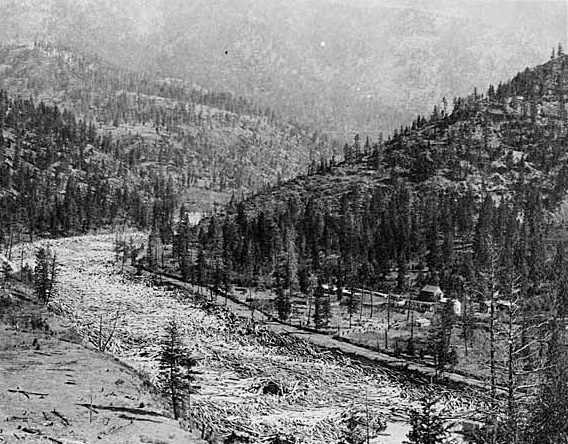 An early day logging crew in the Blackfoot Men who worked in the woods or on the river often also worked in the mill during its operating season, from April to October. Milltown, with its saloons and boarding houses, was their home when they were not in the camps. And though these camps were located some 25 miles upstream from the Bonner-Milltown-West Riverside area, the men were part of those communities.
An early day logging crew in the Blackfoot Men who worked in the woods or on the river often also worked in the mill during its operating season, from April to October. Milltown, with its saloons and boarding houses, was their home when they were not in the camps. And though these camps were located some 25 miles upstream from the Bonner-Milltown-West Riverside area, the men were part of those communities.
The first camp at Fish Creek involved 50 men, who cut some 200,000 board feet of logs during the winter of 1885-86. These were floated down the Blackfoot in time to await the opening of the new Hammond-Bonner mill in June of 1886. Logs were in the river as much as 45 days. Initially, there was no road up the Blackfoot, so workers reached the camps from Wallace (now known as Clinton). Horses were used to haul logs out of the woods Trees were cut by hand using axes and large, two-person crosscut saws. Logs were brought to the river by oxen or teams of horses. Some logging camps had 300 work horses in operation at one time. Oxen were also used, especially as they were plentiful after the Northern Pacific Railroad was completed, when they were no longer needed to carry track building supplies.
Horses were used to haul logs out of the woods Trees were cut by hand using axes and large, two-person crosscut saws. Logs were brought to the river by oxen or teams of horses. Some logging camps had 300 work horses in operation at one time. Oxen were also used, especially as they were plentiful after the Northern Pacific Railroad was completed, when they were no longer needed to carry track building supplies.
Once in the river, a bateau (a flat bottomed river boat) followed the logs to keep them moving, manned by a crew of six. The first boat was 46 feet long and was built by Henry Farrell and Frank Thibodeau, who brought river drive experience from their work in the eastern forests of New Brunswick and Quebec. The men would “burl” the logs to get them free and moving. Rita LaVoie, who grew up in Milltown, shared the story that her father had taught her to burl logs by moving her feet to get the logs rolling. She would compete with others, clamping her feet to throw off an opponent. The Blackfoot River floated logs
The Blackfoot River floated logs
to the mill until 1926. Eventually other forms of transportation brought an end to the log drives. The Anaconda Company took over the Big Blackfoot Milling Company mill in 1898. By 1904 their railroad began operating with Shay locomotives from Greenough to McNamara, where the logs were dumped off into the river and floated to Bonner. This rapidly proved more efficient than the long log drives. By 1910 the Big Blackfoot Railway was incorporated, and construction began to extend the line to Bonner.
In 1913 the Milwaukee Railroad purchased the Big Blackfoot Railway from the Anaconda Company and completed the track to Bonner. They brought logs from the logging camps in the Blackfoot until the mid-1930s, when yet another form of transportation edged its way into the logging scene.
 Trains brought logs to the mill until the 1930s, when they were replaced by logging trucks. Logging trucks could go places the railroad could not and offered even more efficiency. Gradually replacing the railroad, logging trucks carried logs from the woods all the way to the mill by 1957.
Trains brought logs to the mill until the 1930s, when they were replaced by logging trucks. Logging trucks could go places the railroad could not and offered even more efficiency. Gradually replacing the railroad, logging trucks carried logs from the woods all the way to the mill by 1957.
The logging camps continued, centered for much of the time in Potomac, until the last camp was disbanded in 1960. Truck operations then were based at Twin Creeks, nine miles up the Blackfoot.
